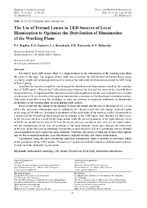| dc.contributor.author | Bogdan, P. S. | |
| dc.contributor.author | Zaytseva, E. G. | |
| dc.contributor.author | Kovalenok, I. A. | |
| dc.contributor.author | Tarasenko, T. D. | |
| dc.contributor.author | Duboysky, E. V. | |
| dc.coverage.spatial | Минск | ru |
| dc.date.accessioned | 2023-08-15T08:59:02Z | |
| dc.date.available | 2023-08-15T08:59:02Z | |
| dc.date.issued | 2023 | |
| dc.identifier.citation | The Use of Fresnel Lenses in LED Sources of Local Illumination to Оptimize the Distribution of Illumination of the Working Plane = Использование линзы Френеля в светодиодных источниках локального освещения для оптимизации распределения освещённости рабочей плоскости / P. S. Bogdan [et al.] // Приборы и методы измерений. – 2023. – Т. 14, № 2. – С. 96-105. | ru |
| dc.identifier.uri | https://rep.bntu.by/handle/data/133668 | |
| dc.description.abstract | For widely used LED sources there is a sharp decrease in the illumination of the working plane from the center to the edge. The purpose of this study was to analyze the effectiveness of Fresnel lenses usage as a fairly simple and technological element to increase the uniformity of illumination created by LED lamps of local lighting. A method has been developed for calculating of the distribution of illumination created by the combination of “LED matrix – Fresnel lens” when the distance between the lens and the matrix is less than the focal length of the lens. Comparison of the calculation results and experiments for the case when the lens is located at a distance of 50 cm from the working plane indicates the correctness of the developed calculation method. This made it possible to use this technique to solve the problem of improved uniformity of illumination distribution in the working plane of local lighting LED sources. It was found that the change in the distance between the matrix and the lens in the range of 0.5–1.5 cm affects the maximum illumination and its uniformity to a lesser extent than the change in focal lengths in the range of 10–100 cm. Analytical dependences of the uniformity of the working surface illumination as a function of the Fresnel lens focal length and its distance to the LED matrix were obtained for three cases. In the first case one lens is used for the entire matrix while the axes of symmetry of the light intensity curves of LEDs are parallel to the axis of the lens. In the second case one lens is also used for the entire matrix, but the continuations of the axes of symmetry of the light intensity curves pass through the front focus of the lens. In the third one an individual Fresnel lens is used for each LED. It is established that for all three cases dependencies have almost the same character. Therefore, the choice of using one of these three options may be due to manufacturability, cost-effectiveness, thermal stability, and other considerations. Calculations using the above-mentioned analytical dependences made it possible to determine values of the parameters of the “LED matrix – Fresnel lens” system at which the indicators of illumination and uniformity meet the standards’ requirements. | ru |
| dc.language.iso | en | ru |
| dc.publisher | БНТУ | ru |
| dc.title | The Use of Fresnel Lenses in LED Sources of Local Illumination to Оptimize the Distribution of Illumination of the Working Plane | ru |
| dc.title.alternative | Использование линзы Френеля в светодиодных источниках локального освещения для оптимизации распределения освещённости рабочей плоскости | ru |
| dc.type | Article | ru |
| dc.identifier.doi | 10.21122/2220-9506-2023-14-2-96-105 | |
| local.description.annotation | Для широко используемых светодиодных источников света имеет место резкий спад освещённости рабочей плоскости от центра к краю. Целью настоящего исследования являлся анализ эффективности применения линз Френеля как достаточно простого и технологичного элемента для увеличения равномерности освещённости, создаваемой светодиодными светильниками локального освещения. Разработана методика расчёта распределения освещённости, создаваемой комбинацией «светодиодная матрица – линза Френеля», когда расстояние между линзой и матрицей меньше фокусного расстояния линзы. Сравнение результатов расчёта и экспериментов для случая, когда линза располагается на расстоянии 50 см от рабочей плоскости, свидетельствует о корректности разработанной методики расчёта. Это позволило использовать данную методику для решения задачи повышения равномерности освещённости рабочей плоскости в светодиодных источниках локального освещения. Установлено, что изменение расстояния между матрицей и линзой в диапазоне 0,5–1,5 см влияют на максимальную освещённость и её равномерность в меньшей степени, чем изменение фокусных расстояний в пределах 10–100 см. Получены аналитические зависимости равномерности освещённости рабочей поверхности как функции фокусного расстояния линзы Френеля и её расстояния до светодиодной матрицы для трёх случаев. В первом случае используется одна линза для всей матрицы, при этом оси симметрии кривых силы света светодиодов параллельны оси линзы. Во втором случае также используется одна линзы для всей матрицы, но продолжения осей симметрии кривых силы света проходят через передний фокус линзы. В третьем – для каждого светодиода используется индивидуальная линза Френеля. Установлено, что для всех трёх случаев зависимости имеют практически одинаковый характер. Поэтому выбор использования одного из трёх вариантов может быть обусловлен технологичностью, экономичностью и термической устойчивостью и др. Расчёты с использованием выше упомянутых аналитических зависимостей позволили определить значения параметров системы «светодиодная матрица – линза Френеля», при которых показатели освещённости и равномерности соответствуют требованиям стандартов. | ru |

